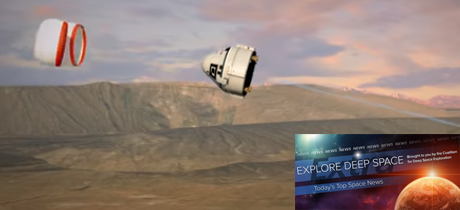In Today’s Deep Space Extra… NASA discusses with Russia the purchase of more seats on Soyuz spacecraft to transport astronauts to and from the International Space Station (ISS) as efforts to by the agency to certify Boeing’s CST-100 Starliner and SpaceX’s Crew Dragon move ahead. Assessing the best ways to explore space require an open mind.
Human Space Exploration
Boeing closing in on Starliner pad abort test
Coalition Member in the News – Boeing
Spaceflightnow.com (10/1): Boeing, one of two NASA Commercial Crew Program partners, is preparing for a fall pad abort test of its CST-100 Starliner at test facilities at White Sands New Mexico. The test is uncrewed. Boeing is also preparing for an uncrewed and crewed test flights of the Starliner to the International Space Station (ISS) to achieve certification for the regularly scheduled transportation of astronauts to and from the orbiting science lab.
NASA, Roscosmos in talks on more Soyuz seats to maintain U.S. presence on ISS through 2020
Coalition Member in the News – Boeing
Sputnik News of Russia (10/2): NASA and Roscosmos, the Russian space agency, are in talks to secure seats for astronauts aboard Soyuz rockets headed for the International Space Station (ISS) after March 2020 in order to assure a continuing U.S. presence on the orbiting science lab. The discussions were prompted by delays in efforts to certify NASA’s Commercial Crew Program Boeing CST.
Space Science
Chandrayaan-2: ISRO has not given up efforts to regain link with lander Vikram
New Indian Express (10/1): The ISRO has not given up efforts to spring Chandrayaan-2’s lander Vikram lying on the lunar surface back to life after a hard-landing more than three weeks ago, senior officials indicated on Tuesday. The Indian Space Research Organization (ISRO) said on September seven ground stations lost communication with Vikram (with rover Praygan tucked inside it), minutes before its planned soft-landing on the lunar surface.
Confirmed. Fossils that formed 3.5 billion years ago, really are fossils. The oldest evidence of life found so far
Universe Today (9/30): Australia’s Pilbara region can once again claim evidence in the form of cyanobacteria fossils for the earliest life on Earth. These single celled relics of early life formed 3.5 billion years ago, according to details published in the journal Geology.
How long will the Hubble Space Telescope last?
Astronomy.com (10/1): Since its launch in April 1990, the Hubble Space Telescope (HST) has afforded astronomers an unprecedented view of the universe. Five space shuttle upgrade missions have given the HST a life expectancy until at least June 30, 2021. Unless its gets a reboost, however, atmospheric drag is expected to cause the observatory to re-enter the Earth’s atmosphere by the mid-2030’s. And major science instruments are beginning to show their age.
Other News
Relativity Space raises $140M to stay on track for 3-D printed rocket’s launch
GeekWire.com (10/1): Los Angeles based Relativity Space says its raised $140 million, enough to finance efforts to develop and launch the first all 3-D printed rocket in 2021 and enter commercial service. The company has a target price of $10 million for the launch of a 2,750 pound payload into low Earth orbit.
Making the rules in space: When does careful become crushing? (Op ed)
The Hill (10/1): Our collective experience in space is still maturing, writes Ryan Faith, a space policy consultant, in an op-ed. It’s too early to restrict new approaches to exploration and expanding the space economy with engineering assumptions and restrictive regulations, he suggests.
How NASA’s planetary defense budget grew by more than 4000% in 10 years
Planetary Society (9/26): Awareness is growing that major asteroid encounters are rare but potentially treacherous. As NASA spends more on planetary defense, two missions are on the horizon. Slated to launch in 2021, the DART mission will attempt to demonstrate the effectiveness of a impactor in changing the course of a hazardous asteroid. Recently, NASA committed to the development of a follow on mission, the Near Earth Object Surveillance Mission, an infrared space telescope positioned in space to discover and track asteroids 140 meters and larger that could pose an impact threat.
World View’s ‘Stratollite’ balloon stays aloft for record 32 days
Space.com (10/1): Tucson based World View Enterprises, Inc., which is exploring a commercial market for high altitude balloon Earth observations announced Tuesday a successful 32 day demonstration mission that drew to a close at the Nebraska/Iowa border on September 28. The long flight spanned 11,200 kilometers, or 7,000 miles, as the 40 story tall Stratollite balloon and its payload sailed over parts of 10 states after departing Page, Arizona.
What’s up – October 2019
NASA/Jet Propulsion Laboratory (10/1): Saturday is International Observe the Moon Night. Also, in October the ice giant planets Uranus and Neptune are well placed in the western sky after sunset for observation — with telescope.

